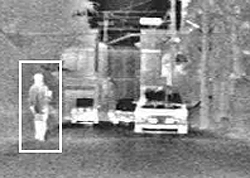Honda Develops World's First Intelligent Night Vision System Able to Detect Pedestrians and Provide Driver Cautions-Available on Legend model to be released in Fall 2004-
August 24, 2004, Japan
August 24, 2004-Honda Motor Co., Ltd. announced today that it has developed the world's first Intelligent Night Vision System, which uses "far infrared" cameras to detect pedestrians in or approaching the vehicle's path and provides the driver visual and audio cautions to help prevent accidents involving pedestrians. The new system will be available on the Honda Legend to be released in Japan in fall 2004.
The Intelligent Night Vision System uses images obtained from two far infrared cameras positioned in the lower section of the front bumper to detect the position and movement of infrared heat-emitting objects and determine whether they are in or approaching the vehicle's path. Based on size and shape, the system also determines if the detected object is a pedestrian. In addition to the conventional night vision function of giving the driver an enhanced view of the road ahead, the system is the world's first to provide cautions that inform the driver of the presence of pedestrians that are on the road or about to cross the vehicle's path.
Pedestrian fatalities make up approximately 30% of all traffic accident fatalities in Japan*. In its ongoing efforts to reach a better understanding of the kinematics of pedestrian accidents and to develop technologies to protect pedestrians, Honda developed the world's first pedestrian dummy, POLAR I, in 1988. This was followed by POLAR II in 2000, which features an even more human-like structure and more points of measurement. Honda places a high priority on the development of new pedestrian safety technologies. Given that 70% of all pedestrian fatalities are said to occur at night, the independently developed Intelligent Night Vision System addresses a vital problem. Honda is committed to the further development of technologies designed to help prevent accidents involving pedestrians.
*Source: ITARDA (Institute for Traffic Accident Research and Data Analysis) traffic statistics, 2003

Viewed with naked eye

Viewed with Intelligent Night Vision
System
●Intelligent Night Vision System configuration
- Far infrared camera The camera obtains a visual image based on the "far infrared" radiation emitted by humans and other objects. Because it uses far infrared radiation, it is capable of obtaining a viable image without the use of a light source, as is required by visible-light or "near infrared" cameras.
- Heads-up display The image is reflected in a mirror positioned on top of the dashboard, which retracts into the dashboard for daytime stowage.
- Pedestrian detecting ECU The ECU determines pedestrian position and motion based on the image from the cameras, along with vehicle speed and other vehicle information. The system detects pedestrians in or approaching the vehicle's path, and provides caution to the driver via a visual enhancement frame around the pedestrian image and an audio caution.
- Sensors Headlight on/off information, windshield wiper setting, yaw rate, vehicle speed, ambient temperature.
●Control system flow
